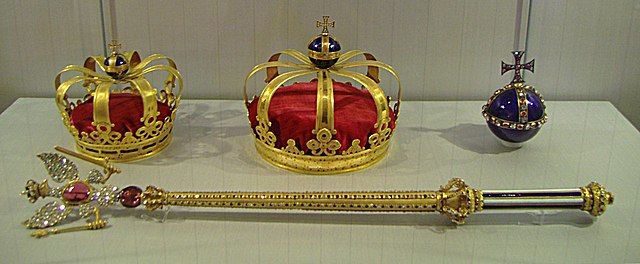320 years ago today there took place in the castle at Konigsberg in East Prussia the coronation of King Friedrich I and his Queen Sophia Charlotte, who was the sister of the future King George I of Great Britain.
King Friedrich I
He is shown in his coronation mantle and with the Prussian regalia. He is wearing the collar of the Order of the Black Eagle which he also established in 1701.
Image: Wikipedia
United in a personal union since 1618 to the Electoral Margravate of Brandenburg the Duchy of Prussia had been raised to the status of a Kingdom by an agreement made by the Elector Margrave and Duke with the Holy Roman Emperor Leopold I on November 16th 1700. By this the Duchy, being outside the Empire was elevated to being a kingdom. Due to the long and conflicted relationship of the Duchy to Poland, largely resolved in treaties in 1657 and 1660, and although King Augustus II, himself also the Elector of Saxony within the Empire, was agreeable the Polish Sejm raised objections. As a result the new King was styled as King in Prussia not King of Prussia. This was just Ducal or East Prussia, as opposed to Royal or West Prussia which formed part of Poland until the First Partition of 1772. Only when the first Prussian King’s grandson, Friedrich the Great, secured that territory did he change his title to King of Prussia.
Christopher Clark in The Iron Kingdom includes a description of the ceremonies on January 18th 1701. They combined contemporary concepts of royal absolutism when the new King crowned himself and then his Queen within the schloss and a much older feudal ceremony with his subjects pledging their allegiance with a raised arm gesture. Never mind unfortunate twentieth century parallels in Germany the same traditional gesture could be seen at the Dutch enthronement ceremony in 2013.
The regalia that was made for the coronation can be seen today at Charlottenberg Palace in Berlin. There is a brief account of it at Prussian Crown Jewels
The Prussian Regalia
Image: Wikipedia
There is a fairly brief account of King Friedrich I in a Wikipedia article at Frederick I of Prussia
As King he enjoyed and encouraged a Baroque Court culture. Today that can be seen in buildings in Berlin - the rebuilt Stadtschloss and Charlottenburg , named after his beloved consort. This world was disdained by his son and successor Friedrich Wilhelm I and in many ways by his son Friedrich the Great. One consequence was that the actual coronation disappeared from the ceremonies accompanying the monarch’s accession.
The next proper coronation at Konigsberg was not until 1861 when King Wilhelm I celebrated his there with the coronation in the castle chapel and the allergen e ceremony in the courtyard. This is the first coronation of which there are not just paintings but also photographs.
When in 1888 the Kaiser-King Wilhelm II acceded he proposed a coronation at Konigsberg but was dissuaded by Bismarck on the argument that such events belonged to the past. This was perhaps on a par with the trend in the Scandinavian monarchies to abandon coronations in Denmark in 1863, in Sweden in 1907 and to remove the constitutional requirement for it in Norway at the same time. What this did not foresee was the potential realised in the UK from 1902 of such ceremonies binding the popular imagination to the monarchy. Bismarck was less conservative than might be thought and his new monarch less determined than he is often presented. That said the new Kaiser-King had a new Prussian crown made in 1889 and in his early years as monarch was not infrequently depicted with it at his side in paintings and photographs.
The day before his coronation the King established the Order of the Black Eagle, which became the premier chivalric Order of the Hohenzollern monarchy. I posted about that in 2011 at Order of the Black Eagle of Prussia
I have posted previously about the establishment of the Kingdom in Prussia in 2016 at Inaugurating the Prussian Kingdom
Both of these posts have additional images as well as other details and links.




No comments:
Post a Comment